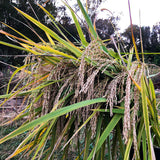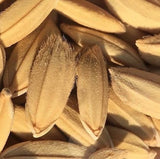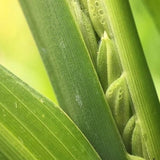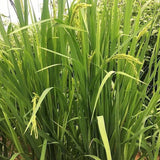Hill Rice (South Trinidad)
Oryza spp.
Also known as red bearded upland rice, this special dry-farmed rice has a deep and important history in all parts of the twin islands of Trinidad and Tobago. We grow this rice at Truelove Seeds with limited irrigation with individual plants or several per clump spaced 8-12” apart. This particular selection comes from communities on the south coast of Trinidad, including Moruga. Our original seed came from our dear friend and seed keeper now based in Trinidad who shared this history with us:
Similarities in rice strains and cultivation practices can be used to trace the movement of peoples and plants from specific regions from Africa to the Americas. This very special rice may have been brought to Trinidad via Black soldiers in the war of 1812 who were sent to Trinidad as payment for services by the British army. They were given virgin land in southern Trinidad and after fighting in a war and being uprooted from the American south, they had to learn to cultivate this new land using the knowledge and strength passed down to them. Those soldiers, their families and their cultural ways persevered.
There is evidence that rice predates this history in Trinidad, and it is difficult to trace where this particular strain (one of dozens from the region!) enters the story, but it is certainly a living piece of an African Diasporic tradition of rice cultivation in the Americas.
Days to maturity: 180
Seeds per pack: 90
Germination rate: 97% on 01/21/2025
Planting / harvesting notes
In northern climates like ours, we sow our Hill Rice seeds 4-6 weeks before the last frost, 1 seed per cell, covered ¼ inch. After the last danger of frost has passed, we transplant the seedlings into the garden 8-12 inches apart, in rows 12 inches apart. In Trinidad, farmers direct sow this rice in clumps with many seeds per cluster, spaced 1-2 feet apart during a rainy period. As this is an upland rice, we do not water it any differently than our other vegetable crops. Late in the season when the seed heads begin to droop down heavily with seeds, the rice is nearly ready. Harvest before the last frost when the seed heads turn brown and are very droopy. Watch carefully: many garden pests including rodents and birds will also be looking to harvest the ripe seeds.
Seed keeping notes
See above: for seed saving you harvest at the same time as for food. Harvest low on the seed stalk and allow the seeds to ripen further in a protected place indoors. Remove the seeds by hand or by whacking the seed heads upside down in a large bucket.











